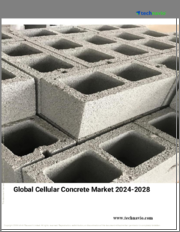
|
시장보고서
상품코드
1628029
기포 콘크리트 시장 기회, 성장 촉진요인, 산업 동향 분석, 예측(2024-2032년)Cellular Concrete Market Opportunity, Growth Drivers, Industry Trend Analysis, and Forecast 2024 - 2032 |
||||||
기포 콘크리트 세계 시장은 2023년 254억 달러로 평가되며, 2024년부터 2032년까지 연평균 4.8%의 성장률을 보일 것으로 전망됩니다.
LEED와 같은 친환경 건축 인증이 각광받고 있는 가운데, 셀룰라 콘크리트는 경량, 단열, 에너지 절약 등의 특성으로 인해 지속가능한 재료로 인정받고 있습니다. 지속가능한 재료로 인식되고 있습니다. 또한, 제조 기술의 발전으로 그 용도가 확대되어 건설 산업에서 그 매력이 더욱 커지고 있습니다.
시장에 크게 기여하고 있는 기포 콘크리트 부문은 2023년 166억 달러로 평가되며, 2024-2032년 CAGR 4.9% 성장할 것으로 예상됩니다. 경량 특성으로 알려진 기포 콘크리트는 구조 중량 감소가 필요한 프로젝트에서 분명한 이점을 제공합니다. 특히 기초 응력 감소가 중요한 고층 빌딩 및 기타 다층 구조물에서 그 채택이 두드러집니다. 또한, 이러한 특성으로 인해 구조적 탄력성이 필수적인 지진이 잦은 지역에서도 선호되는 선택이 되고 있습니다.
최종 용도별로는 건설 및 건축 분야가 2023년 53%의 점유율을 차지하며 2032년까지 5.1%의 CAGR을 기록할 것으로 예상됩니다. 기포 콘크리트는 경량화, 운송 비용 절감, 기초 요건 간소화, 인건비 절감 등의 장점으로 건설 분야에서 높은 평가를 받고 있습니다. 단열 성능은 실내 온도를 일정하게 유지하여 HVAC 시스템에 대한 의존도를 낮추고 에너지 효율적이고 지속가능한 건축 솔루션에 대한 관심이 높아지는 추세에 부합합니다. 개발 담당자들이 엄격한 환경 기준을 충족시키기 위해 노력하는 가운데, 셀룰라 콘크리트는 최신 건설 프로젝트에서 선택되는 재료로 부상하고 있습니다.
| 시장 범위 | |
|---|---|
| 시작 연도 | 2023년 |
| 예측 연도 | 2024-2032년 |
| 시작 금액 | 254억 달러 |
| 예상 금액 | 387억 달러 |
| CAGR | 4.8% |
미국 기포 콘크리트 시장은 2023년 84%의 점유율을 차지했습니다. 이 지역에서는 저렴한 주택 및 인프라 구축에 대한 수요로 인해 건설 활동이 활발해지면서 기포 콘크리트의 채택이 가속화되고 있습니다. 가볍고 에너지 효율이 뛰어나며 비용 효율성이 높아 다양한 건설 프로젝트에서 사용하기에 적합합니다. 주거 및 상업용 건물부터 교량 및 공공 시설과 같은 중요한 인프라에 이르기까지, 셀룰라 콘크리트는 미국 건설 환경에서 핵심적인 재료로 자리 잡고 있습니다. 시장의 성장은 경제적 효율성과 환경적 지속가능성이라는 두 가지 요구 사항을 충족하는 능력에 의해 더욱 뒷받침되고 있습니다.
목차
제1장 조사 방법과 조사 범위
제2장 주요 요약
제3장 업계 인사이트
- 생태계 분석
- 밸류체인에 영향을 미치는 요인.
- 이익률 분석
- 파괴
- 향후 전망
- 제조업체
- 유통업체
- 공급업체 상황
- 이익률 분석
- 주요 뉴스와 이니셔티브
- 규제 상황
- 영향요인
- 성장 촉진요인
- 경량 소재 수요 증가
- 에너지 효율 향상을 위한 건설 증가
- 업계의 잠재적 리스크와 과제
- 한정적인 인식과 수용
- 성장 촉진요인
- 성장 가능성 분석
- Porters 분석
- PESTEL 분석
제4장 경쟁 구도
- 소개
- 기업 점유율 분석
- 경쟁 포지셔닝 매트릭스
- 전략 전망 매트릭스
제5장 시장 추정과 예측 : 생산 방식별, 2021-2032년
- 주요 동향
- 발포 콘크리트
- 기포 콘크리트
제6장 시장 추정과 예측 : 밀도별, 2021-2032년
- 주요 동향
- 저밀도(600 kg/m3 이하)
- 중밀도(601 kg/m3 이상 1,199 kg/m3 미만)
- 고밀도(1,200 kg/m3 이상)
제7장 시장 추정과 예측 : 용도별, 2021-2032년
- 주요 동향
- 공극 충전
- 플로어 데크
- 루프 데크
- 내벽
- 서멀 백 필과 서브 슬래브 필
- 보도
- 파티오
- 기타(펜스 패널, 토양 정화 등)
제8장 시장 추정과 예측 : 최종 용도별, 2021-2032년
- 주요 동향
- 건설·건축
- 인프라
- 산업용
- 기타(해양·오프쇼어, 온실 등)
제9장 시장 추정과 예측 : 지역별, 2021-2032년
- 주요 동향
- 북미
- 미국
- 캐나다
- 유럽
- 영국
- 독일
- 프랑스
- 이탈리아
- 스페인
- 러시아
- 아시아태평양
- 중국
- 인도
- 일본
- 한국
- 호주
- 라틴아메리카
- 브라질
- 멕시코
- 중동 및 아프리카
- 아랍에미리트
- 사우디아라비아
- 남아프리카공화국
제10장 기업 개요
- Aerix Industries
- AeroConcrete Inc.
- Cellular Concrete Solutions
- Cellular Concrete Technologies(CCT)
- CEMATRIX
- Cemex
- Gulf Precast Concrete Company
- Knauf Insulation
- LafargeHolcim
- LBT Power South Africa(Pty) Ltd.
- Sika AG
- The Aircrete Group
- The Conco Companies
- U.S. Concrete, Inc.
- Xella Group
The Global Cellular Concrete Market reached USD 25.4 billion in 2023 and is projected to grow at a CAGR of 4.8% from 2024 to 2032. The growing emphasis on sustainability and energy efficiency in construction is driving demand for cellular concrete across residential and commercial sectors. With green building certifications such as LEED gaining prominence, cellular concrete is increasingly recognized as a sustainable material due to its lightweight, insulating, and energy-saving properties. Additionally, advancements in manufacturing technologies are expanding its applications and boosting its appeal in the construction industry.
The aerated concrete segment, a significant contributor to the market, was valued at USD 16.6 billion in 2023 and is expected to grow at a CAGR of 4.9% during 2024-2032. Known for its lightweight characteristics, aerated concrete offers a distinct advantage in projects requiring reduced structural weight. Its adoption is particularly prominent in high-rise buildings and other multi-story structures, where reducing foundation stress is critical. These properties also make it a preferred choice in seismically active regions where structural resilience is essential.
In terms of end-use, the construction and building sector dominated the market with a 53% share in 2023 and is anticipated to grow at a CAGR of 5.1% through 2032. Cellular concrete is highly valued in construction due to its lightweight nature, which reduces transportation costs, simplifies foundation requirements, and lowers labor expenses. Its thermal insulation capabilities help maintain consistent indoor temperatures, reducing reliance on HVAC systems and aligning with the increasing focus on energy-efficient and sustainable building solutions. As developers strive to meet stringent environmental benchmarks, cellular concrete emerges as a material of choice for modern construction projects.
| Market Scope | |
|---|---|
| Start Year | 2023 |
| Forecast Year | 2024-2032 |
| Start Value | $25.4 Billion |
| Forecast Value | $38.7 Billion |
| CAGR | 4.8% |
U.S. cellular concrete market accounted for 84% share in 2023. The region's growing construction activity, driven by demand for affordable housing and infrastructure development, is fueling the adoption of cellular concrete. Its lightweight and energy-efficient properties, combined with cost-effectiveness, make it ideal for applications in diverse construction projects. From residential and commercial buildings to critical infrastructure such as bridges and public facilities, cellular concrete is becoming a cornerstone material in the U.S. construction landscape. The market growth is further supported by its ability to meet the dual demands of economic efficiency and environmental sustainability.
Table of Contents
Chapter 1 Methodology & Scope
- 1.1 Market scope & definitions
- 1.2 Base estimates & calculations
- 1.3 Forecast calculations.
- 1.4 Data sources
- 1.4.1 Primary
- 1.4.2 Secondary
- 1.4.2.1 Paid sources
- 1.4.2.2 Public sources
Chapter 2 Executive Summary
- 2.1 Industry synopsis, 2021-2032
Chapter 3 Industry Insights
- 3.1 Industry ecosystem analysis
- 3.1.1 Factor affecting the value chain.
- 3.1.2 Profit margin analysis.
- 3.1.3 Disruptions
- 3.1.4 Future outlook
- 3.1.5 Manufacturers
- 3.1.6 Distributors
- 3.2 Supplier landscape
- 3.3 Profit margin analysis.
- 3.4 Key news & initiatives
- 3.5 Regulatory landscape
- 3.6 Impact forces
- 3.6.1 Growth drivers
- 3.6.1.1 Increasing demand for lightweight materials
- 3.6.1.2 Rising construction of energy-efficiency
- 3.6.2 Industry pitfalls & challenges
- 3.6.2.1 Limited awareness and acceptance
- 3.6.1 Growth drivers
- 3.7 Growth potential analysis
- 3.8 Porter's analysis
- 3.9 PESTEL analysis
Chapter 4 Competitive Landscape, 2023
- 4.1 Introduction
- 4.2 Company market share analysis
- 4.3 Competitive positioning matrix
- 4.4 Strategic outlook matrix
Chapter 5 Market Estimates & Forecast, By Production Method, 2021-2032 (USD Million) (Million/Square Feet)
- 5.1 Key trends
- 5.2 Foam concrete
- 5.3 Aerated concrete
Chapter 6 Market Estimates & Forecast, By Density, 2021-2032 (USD Million) (Million/Square Feet)
- 6.1 Key trends
- 6.2 Low density (600 kg/m3 and below)
- 6.3 Medium density (Between 601 kg/m3 to 1,199 kg/m3)
- 6.4 High density (Above 1,200 kg/m3)
Chapter 7 Market Estimates & Forecast, By Application, 2021-2032 (USD Million) (Million/Square Feet)
- 7.1 Key trends
- 7.2 Void filling
- 7.3 Floor decks
- 7.4 Roof decks
- 7.5 Interior walls
- 7.6 Thermal backfill and sub-slab fill
- 7.7 Sidewalks
- 7.8 Patios
- 7.9 Others (Fence Panels, Soil Remediation, Etc)
Chapter 8 Market Estimates & Forecast, By End Use, 2021-2032 (USD Million) (Million/Square Feet)
- 8.1 Key trends
- 8.2 Construction & building
- 8.3 Infrastructure
- 8.4 Industrial
- 8.5 Others (Marine & Offshore, Greenhouses, Etc)
Chapter 9 Market Estimates & Forecast, By Region, 2021-2032 (USD Million) (Million/Square Feet)
- 9.1 Key trends
- 9.2 North America
- 9.2.1 U.S.
- 9.2.2 Canada
- 9.3 Europe
- 9.3.1 UK
- 9.3.2 Germany
- 9.3.3 France
- 9.3.4 Italy
- 9.3.5 Spain
- 9.3.6 Russia
- 9.4 Asia Pacific
- 9.4.1 China
- 9.4.2 India
- 9.4.3 Japan
- 9.4.4 South Korea
- 9.4.5 Australia
- 9.5 Latin America
- 9.5.1 Brazil
- 9.5.2 Mexico
- 9.6 MEA
- 9.6.1 UAE
- 9.6.2 Saudi Arabia
- 9.6.3 South Africa
Chapter 10 Company Profiles
- 10.1 Aerix Industries
- 10.2 AeroConcrete Inc.
- 10.3 Cellular Concrete Solutions
- 10.4 Cellular Concrete Technologies (CCT)
- 10.5 CEMATRIX
- 10.6 Cemex
- 10.7 Gulf Precast Concrete Company
- 10.8 Knauf Insulation
- 10.9 LafargeHolcim
- 10.10 LBT Power South Africa (Pty) Ltd.
- 10.11 Sika AG
- 10.12 The Aircrete Group
- 10.13 The Conco Companies
- 10.14 U.S. Concrete, Inc.
- 10.15 Xella Group

















